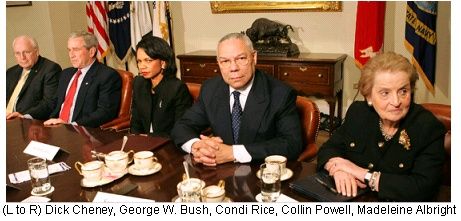
|
NEDERLANDS | ENGLISH
|
|
|
16 April 2010 |
 mail this article
| mail this article
|
 print
| print
|  | Michael Collins | Michael Collins
WikiLeaks Video – The Greater Horror
By Michael Collins
n Iraq on April 16, 2010 by michaelcollinsefn Tagged: Albright, bugliosi, Bush, Iraq, wikileaks
There they are, the people who brought you every bit of the action in the WikiLeaks video and all of the other horrors flowing from invasion of Iraq. Madeleine Albright (far right, above), former Clinton Secretary of State, is a good place to start. From 60 Minutes:
An exhaustive study found that 227,000 children under five (table 13) died during the George H.W. Bush – Bill Clinton regime of total sanctions against Iraq from 1990 through 2000. But others carry much greater responsibility. The Bush administration had top secret plans to invade Iraq as early as February 2001. First hand witnesses in the prewar White House were unable to name a point when the decision to invade was made. It was a fait accompli. Prior to the war authorization from Congress, the various intelligence agencies submitted a report that claimed Iraq had weapons of mass destruction (WMD). Many nations had WMD. The report had to find that Iraq was an imminent danger to the United States. Here’s the finding:
The NIE is clear: invading Iraq was the potential trigger for an attack on the United States by Iraq. The White House made sure that this critical finding was deleted from their report to Congress. Six thousand U.S. soldiers are dead as a result of the Iraq War. Twenty times that many struggle with serious war injuries. Over one million Iraqi civilians are dead as a result of the chaos unleashed by the invasion (gunshot wounds, car bombings, etc.). This is the true horror of the Iraq War. “Collateral Murder” in Perspective To begin with, this provocative tape, one that we as citizens have every right to see, is a moment in time in a much broader attack on Iraq. The U.S. led sanctions after Gulf War I sought to deny Iraq any imports for over a decade. Saddam Hussein continued to build palaces while the millions who hated him struggled, suffered, and died due to the denial of medicine and other necessary goods. The deadly sanctions ran parallel to regular bombings of Iraq. Those who planned the invasion ignored warnings that Iraq’s rigidly controlled society would collapse without effective post invasion planning. The central piece (of what planning there was) included the Iraq Army as guarantor of order after the invasion. Yet the Army was disbanded. After the loss of this 400,000 man army, who was left to maintain order? Was it “murder”?
Photographer Namir Noor-Eldeen with telephoto lens mistaken for Viewing the 17 minute or 39 minute version of the video tape leads one to focus on two things as a result of the introductory material provided by WikiLeaks. First, we know that a photographer and his assistant were killed along with the driver of a van who attempted to rescue the assistant. We also know that there were two children traveling in the van with the driver, their father. That’s before the tape even starts. Then we’re drawn to the methodical targeting of the men carrying weapons. The initial identification of a weapon was a mistake since, from the introduction, we know that Noor-Eldeen is carrying a telephoto lens, not a RPG. The incorrect identification of a camera as an RPG (above image) is the basis for all that follows in this first segment of the tape – the shooting of the men gathered on the street and the destruction of the van. This is war, a war that was not planned or initiated by the crew of the Apache helicopter. The truly responsible parties for starting the war did so with premeditated intent. They deliberately lied to and deceived the public. They are the very first cause of the war and all of the deaths and suffering. The helicopter crew was called into action, responded, and made a fatal error at the start that was compounded causing the deaths of the Iraqis on the ground. Was this murder? Without doubt, argued one serious analyst. Another, while critical of the mission, had too many unanswered questions to reach that conclusion. But why is there a focus on the Apache crew? When you lock, load and deploy the world’s most powerful military machine, many people die. Civilians die in every war. Several hundred thousand civilians were killed by U.S. and British bombing of German and Japanese cities during World War II. When you hear a president say he’s “sending the troops,” civilian deaths are part of the deal. The most useful questions are the most fundamental. They address the first cause of the war and the means to sustain it. Which members of the administration were responsible for concocting the lies that were used to take the United States to war? Which members of Congress voted again and again to fund the war once the facts surfaced about the lies used to start the war (even before the invasion)? However the dead ended up that way, the premeditated lies used to launch an invasion and occupation and those who enabled this by deliberately ignoring the truth are clearly the responsible parties for “collateral murder.” Will one of them step forward after all of this and say, “We think the price was worth it”? Vincent Bugliosi, before the House Judiciary Committee, July 27, 2008 (6:44) END This article may be reproduced in whole or part with attribution of authorship and a link to this article. See The Prosecution of George W. Bush for Murder by Vincent Bugliosi
____________________________________________________________________________
DeepJournal Sign up for the free mailing list. |


